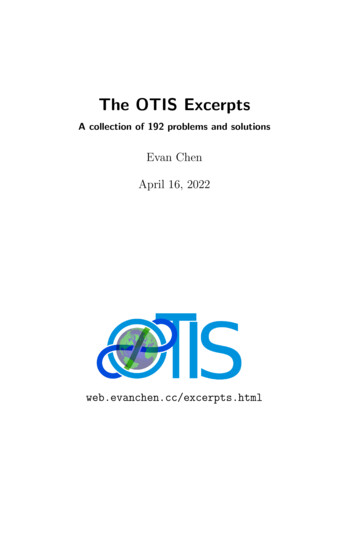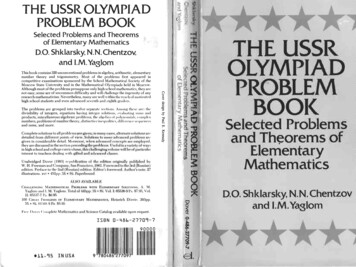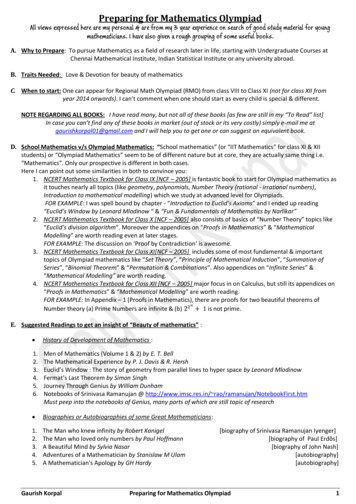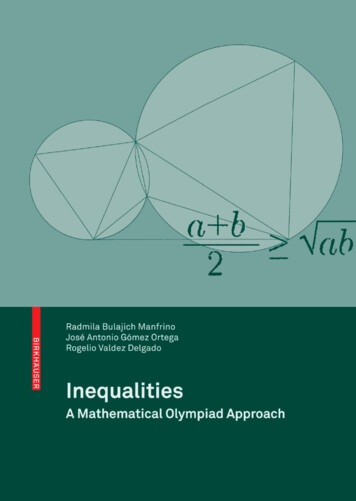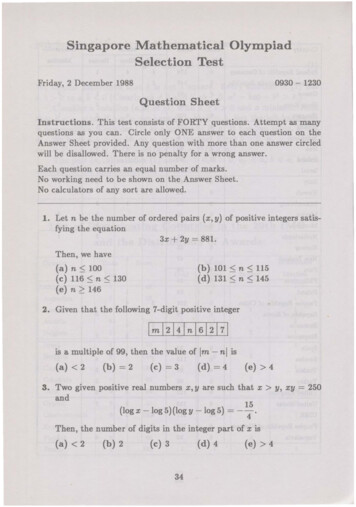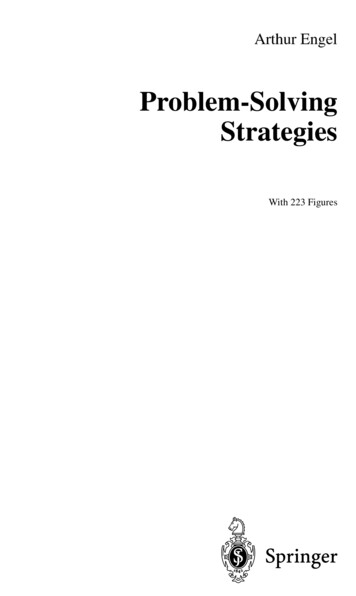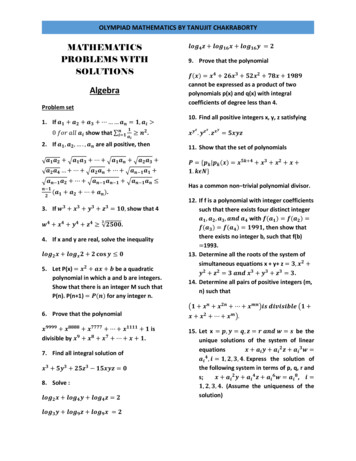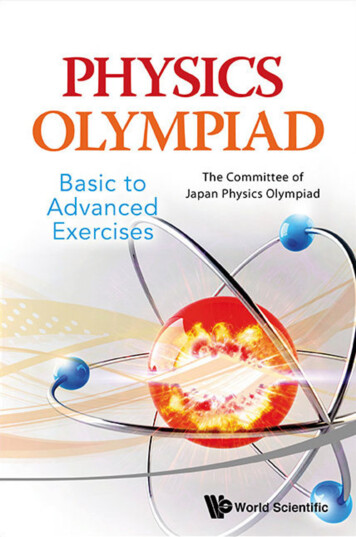
Transcription
PHYSICSOLYMPIADBasic to Advanced Exercises8887 9789814556675 tp.indd 12/12/13 3:06 PM
This page intentionally left blank
PHYSICSOLYMPIADBasic to Advanced ExercisesThe Committee ofJapan Physics OlympiadWorld ScientificNEW JERSEY LONDON8887 9789814556675 tp.indd 2 SINGAPORE BEIJING SHANGHAI HONG KONG TA I P E I CHENNAI2/12/13 3:06 PM
Published byWorld Scientific Publishing Co. Pte. Ltd.5 Toh Tuck Link, Singapore 596224USA office: 27 Warren Street, Suite 401-402, Hackensack, NJ 07601UK office: 57 Shelton Street, Covent Garden, London WC2H 9HELibrary of Congress Cataloging-in-Publication DataCommittee of Japan Physics Olympiad.Physics Olympiad : basic to advanced exercises / The Committee of Japan Physics Olympiad.pages cmIncludes index.ISBN-13: 978-9814556675 (pbk. : alk. paper)ISBN-10: 981455667X (pbk. : alk. paper)1. Physics--Problems, exercises, etc. 2. Physics--Competitions. I. Title.QC32.C623 2013530.076--dc232013037572British Library Cataloguing-in-Publication DataA catalogue record for this book is available from the British Library.Copyright 2014 by World Scientific Publishing Co. Pte. Ltd.All rights reserved. This book, or parts thereof, may not be reproduced in any form or by any means,electronic or mechanical, including photocopying, recording or any information storage and retrievalsystem now known or to be invented, without written permission from the publisher.For photocopying of material in this volume, please pay a copying fee through the Copyright ClearanceCenter, Inc., 222 Rosewood Drive, Danvers, MA 01923, USA. In this case permission to photocopyis not required from the publisher.In-house Editor: Song YuTypeset by Stallion PressEmail: enquiries@stallionpress.comPrinted in Singapore
December 9, 201315:259inx6inPhysics Olympiad: Basic to Advanced Exercisesb1653-fmPreface to the English EditionThe Committee of Japan Physics Olympiad (JPhO), a non-profitorganization approved and supported by the Japanese government,has organized Physics Challenge, a domestic competition in physics,for high-school students, every year since 2005 and has also selectedand sent the best five students to represent Japan in the InternationalPhysics Olympiad (IPhO) every year since 2006. The main aim ofthe activity of our Committee is to promote and stimulate highschool–level physics education in Japan so as to achieve a world-classstandard, which we have experienced during the IPhO.Physics Challenge consists of three stages: the First Challenge,the Second Challenge, and the Challenge Final. The First Challengeselects about 100 students from all applicants (1000 1500 in totalevery year); every applicant is required to take a theoretical examination (90 min, multiple-choice questions) held at more than 70 placeson a Sunday in June, and to submit a report on an experimentdone by himself. The subject of the experiment is announced severalmonths before the submission deadline.The Second Challenge is a four-day camp held in August; allstudents in the Second Challenge lodge together for the wholefour days. Each student takes a theoretical examination and anexperimental examination; both are five hours long just like theexaminations in the IPhO.The best 10–15 students who show excellent scores in the SecondChallenge are nominated as candidates for the Japan team for theIPhO. They are then required to participate in a four-day wintercamp at the end of December and a four-day spring camp at theend of March. They are also required to have monthly training viaemail; the training consists of a series of questions and takes placefrom September to March. At the end of the spring camp, thesev
December 9, 2013vi15:259inx6inPhysics Olympiad: Basic to Advanced Exercisesb1653-fmPhysics Olympiad: Basic to Advanced Exercisescandidates take the Challenge Final, which consists of theoretical andexperimental examinations. The best five students are then selectedto form the Japan team for the IPhO.This book contains some of the questions in the theoreticaland experimental examinations of previous Physics Challenges.Elementary Problems in this book are taken from the First Challengecompetitions and Advanced Problems are mostly from the SecondChallenge competitions. Through these questions, we hope that highschool students would become excited and interested in modernphysics. The questions from the Second Challenge reflect the processof development of physics; they ranges from very fundamental physicsof junior-high-school level to the forefront of advanced physics andtechnology. These problems are, we believe, effective in testing thestudents’ ability to think logically, their stamina to concentratefor long hours, their spirit to keep trying when solving intricateproblems, and their interest to do science. We do not require studentsto learn physics by a piecemeal approach. In fact, many of thebasic knowledge of physics for solving the problems are given in thequestions. But, of course, since the competitions at the IPhO requirefundamental knowledge and skills in physics, this book is organizedin such a way that the basics are explained concisely together withsome typical basic questions to consolidate the knowledge.This book is not only meant for training students for physicscompetitions but also for making students excited to learn physics.We often observed that the content of physics education in highschool is limited to basic concepts and it bears little relation tomodern and cutting-edge science and technology. This situation maymake physics class dull. Instead, we should place more emphasis onthe diversity and vastness of the application of physics principles inscience and technology, which is evident in everyday life as well usefulfor gaining a deeper understanding of our past. Therefore, we try inthis book to bridge the gap between the basics and the forefrontof science and technology. We hope that this book will be used inphysics classes in high schools as well as in extracurricular activities.We deeply appreciate the following people for their contributions to translating the original Japanese version into English
December 9, 201315:259inx6inPhysics Olympiad: Basic to Advanced ExercisesPreface to the English Editionb1653-fmviiand editing the manuscript: Kazuo Kitahara, Tadao Sugiyama,Shuji Hasegawa, Kyoji Nishikawa, Masao Ninomiya, John C. GoldStein, Isao Harada, Akira Hatano, Toshio Ito, Kiyoshi Kawamura,Hiroshi Kezuka, Yasuhiro Kondo, Kunioki Mima, Kaoru Mitsuoka,Yusuke Morita, Masashi Mukaida, Yuto Murashita, Daiki Nishiguchi,Takashi Nozoe, Fumiko Okiharu, Heiji Sanuki, Toru Suzuki, SatoruTakakura, Tadayoshi Tanaka, Yoshiki Tanaka, and Hiroshi Tsunemi.January 2013The Committee of Japan Physics Olympiad
December 9, 201315:259inx6inPhysics Olympiad: Basic to Advanced ExercisesThis page intentionally left blankb1653-fm
December 9, 201315:259inx6inPhysics Olympiad: Basic to Advanced Exercisesb1653-fmContentsPreface to the English EditionvPart I. Theory1Chapter 1. General Physics3Elementary Problems . . . . . . . . . . . . . . . . .Problem 1.1. The SI and the cgs systems . . .Problem 1.2. The pressure due to high heelsand elephants . . . . . . . . . . . . . . .Problem 1.3. The part of the iceberg above theProblem 1.4. The altitude angle of the Sun . .Advanced Problems . . . . . . . . . . . . . . . . . .Problem 1.5. Dimensional analysis and scaletransformation . . . . . . . . . . . . . .Problem 1.6. Why don’t clouds fall? . . . . . . . . . . . . . .33. . .sea. . . . .4578. . . . . . . . .811.Chapter 2. Mechanics15Elementary Course . . . . . . . . . . . . . . . . . . . .2.1 Motion with a Constant Acceleration . . . . . .2.1.1 Projectile Motion . . . . . . . . . . . . .2.2 Equation of Motion . . . . . . . . . . . . . . . .2.3 The Law of Conservation of Energy . . . . . . .2.3.1 Work and Kinetic Energy . . . . . . . . .2.3.2 Conservative Forces and Non-conservativeForces . . . . . . . . . . . . . . . . . . . .2.3.3 Potential Energy . . . . . . . . . . . . . .2.3.4 Examples of Potential Energy . . . . . .Gravitational Potential Energy . . . . . . . . . .Elastic Potential Energy . . . . . . . . . . . . .ix.151516171818.2021222222
December 9, 2013x15:259inx6inPhysics Olympiad: Basic to Advanced Exercisesb1653-fmPhysics Olympiad: Basic to Advanced Exercises2.3.5 The Law of Conservation of MechanicalEnergy . . . . . . . . . . . . . . . . . . . . .2.3.6 Energy Transfer between Interacting Bodies .2.3.7 Work Done by Non-conservative Forces . . .2.4 Newton’s Law of Universal Gravitationand Kepler’s Laws . . . . . . . . . . . . . . . . . . .2.4.1 Newton’s Law of Universal Gravitation . . .2.4.2 Gravitational Potential Energy . . . . . . . .2.4.3 Kepler’s Law . . . . . . . . . . . . . . . . . .Elementary Problems . . . . . . . . . . . . . . . . . . . .Problem 2.1. A ball falling from a bicycle . . . . . .Problem 2.2. A ball thrown off a cliff . . . . . . . .Problem 2.3. The trajectory of a ball . . . . . . . .Problem 2.4. The motion of a train . . . . . . . . .Problem 2.5. Skydiving . . . . . . . . . . . . . . . .Problem 2.6. Small objects sliding on differentdescendent paths . . . . . . . . . . . . . . . .Problem 2.7. An inclined plane . . . . . . . . . . . .Problem 2.8. A space probe launched to convergewith the orbit of Pluto . . . . . . . . . . . .Advanced Course . . . . . . . . . . . . . . . . . . . . . . .2.5 Conservation of Momentum . . . . . . . . . . . . . .2.5.1 Momentum and Impulse . . . . . . . . . . . .2.5.2 The Law of Conservation of Momentum . . .2.6 Moment of Force and Angular Momentum . . . . .2.7 The Keplerian Motion . . . . . . . . . . . . . . . . .2.7.1 Two-Dimensional Polar Coordinates . . . . .2.7.2 Universal Gravitation Acting on Planets . . .2.7.3 Moment of Central Forces . . . . . . . . . . .2.7.4 Motion of Planets . . . . . . . . . . . . . . .2.8 Motion and Energy of Rigid Bodies . . . . . . . . .2.8.1 Motion of Rigid Bodies . . . . . . . . . . . .2.8.2 Rotational Kinetic Energy of Rigid Bodies .Advanced Problems . . . . . . . . . . . . . . . . . . . . .Problem 2.9. The Atwood machine with friction . .Problem 2.10. The rotation of rods . . . . . . . . .Problem 2.11. The expanding universe . . . . . . . . . . .242528.29292930313132343639. . .4344.465252525354565658596164656871717885.
December 9, 201315:259inx6inPhysics Olympiad: Basic to Advanced Exercisesb1653-fmxiContentsChapter 3. Oscillations and WavesElementary Course . . . . . . . . . . . . . . . . . .3.1 Simple Harmonic Oscillation . . . . . . . . .3.2 Waves . . . . . . . . . . . . . . . . . . . . . .Elementary Problems . . . . . . . . . . . . . . . .Problem 3.1. A graph of a sinusoidal wave .Problem 3.2. An observation of sound usingmicrophones . . . . . . . . . . . . . .Advanced Course . . . . . . . . . . . . . . . . . . .3.3 Superposition of Waves . . . . . . . . . . . .3.3.1 The Young’s Double-Slit Experiment3.3.2 Standing Waves . . . . . . . . . . . .3.3.3 Beats . . . . . . . . . . . . . . . . . .3.4 The Doppler Effect . . . . . . . . . . . . . .3.4.1 The Doppler Effect of Light . . . . . .3.4.2 Shock Waves . . . . . . . . . . . . . .Advanced Problems . . . . . . . . . . . . . . . . .Problem 3.3. The propagation velocityof a water wave . . . . . . . . . . . . .Problem 3.4. The dispersion of light andrefractive index . . . . . . . . . . . . .91.9191939696.98100100100103106107109109110. . . . . .110. . . . . .115Chapter 4. ElectromagnetismElementary Course . . . . . . . . . . . . . . . . . . .4.1 Direct-Current Circuits . . . . . . . . . . . . .4.1.1 Electric Current and Resistance . . . .Definition of the unit of current and Ohms lawResistivity . . . . . . . . . . . . . . . . . . . .4.1.2 Resistors in Series and in Parallel . . .4.1.3 Kirchhoff’s Rules . . . . . . . . . . . . .Kirchhoff’s junction rule . . . . . . . . . . . .4.2 Magnetic Field and Electromagnetic Induction4.2.1 Magnetic Field . . . . . . . . . . . . . .4.2.2 Magnetic Force on Current . . . . . . .4.2.3 Electromagnetic Induction . . . . . . .123.123123123123124124126126126127128128
December 9, 2013xii15:259inx6inPhysics Olympiad: Basic to Advanced Exercisesb1653-fmPhysics Olympiad: Basic to Advanced ExercisesElementary Problems . . . . . . . . . . . . . . . . . . . . . .Problem 4.1. A circuit with two batteries . . . . . . . .Problem 4.2. A three-dimensional connectionof resistors . . . . . . . . . . . . . . . . . . . . .Problem 4.3. A hand dynamo . . . . . . . . . . . . . .Advanced Course . . . . . . . . . . . . . . . . . . . . . . . . .4.3 Electric Charge and Electric Field . . . . . . . . . . . .4.3.1 Gauss’s Law . . . . . . . . . . . . . . . . . . . .4.3.2 Capacitors and Energy of Electric Field . . . . .4.4 Current and Magnetic Field . . . . . . . . . . . . . . .4.4.1 Magnetic Field Generated by Current in StraightWire . . . . . . . . . . . . . . . . . . . . . . . . .4.4.2 Ampere’s Law . . . . . . . . . . . . . . . . . . .4.4.3 The Lorentz force . . . . . . . . . . . . . . . . .4.4.4 Electromagnetic Induction and Self-Inductance .The law of electromagnetic induction . . . . . . . . . .Advanced Problems . . . . . . . . . . . . . . . . . . . . . . .Problem 4.4. The law of Bio and Savart . . . . . . . . .Problem 4.5. The propagation of electromagneticwaves . . . . . . . . . . . . . . . . . . . . . . . .I The law of electromagnetic inductionin a small area . . . . . . . . . . . . . . . . . . . . .II Maxwell–Ampere’s law . . . . . . . . . . . . . . . .III Maxwell–Ampere’s law in small region . . . . . . .IV The propagation speed of an electromagnetic waveProblem 4.6. The motion of charged particlesin a magnetic field . . . . . . . . . . . . . . . . .Chapter 5. ThermodynamicsElementary Course . . . . . . . . . . . . . . . . .5.1 Heat and Temperature . . . . . . . . . . .5.1.1 Empirical temperature . . . . . . . .5.1.2 One Mole and Avogadro’s Number .5.1.3 Equation of State for Ideal Gas . . .5.1.4 Quantity of Heat and Heat 157157164164165166168171185.185185185185186186
December 9, 201315:259inx6inPhysics Olympiad: Basic to Advanced Exercisesb1653-fmxiiiContentsElementary Problems . . . . . . . . . . . . . . . . . . . .Problem 5.1. Properties of temperature . . . . . . .Problem 5.2. Potential energy and heat . . . . . . .Problem 5.3. Change of the state of an ideal gas . .Problem 5.4. Making water hotter than tea . . . . .Advanced Course . . . . . . . . . . . . . . . . . . . . . . .5.2 Kinetic Theory of Gases . . . . . . . . . . . . . . .5.2.1 Gas Pressure . . . . . . . . . . . . . . . . . .5.2.2 Internal Energy . . . . . . . . . . . . . . . .5.3 The First Law of Thermodynamics . . . . . . . . .5.3.1 Quasi-Static Process . . . . . . . . . . . . . .5.3.2 The First Law of Thermodynamics . . . . . .Advanced Problems . . . . . . . . . . . . . . . . . . . . .Problem 5.5. Brownian motion . . . . . . . . . . . .I Concentration of powder particles and osmoticpressure . . . . . . . . . . . . . . . . . . . . . .II Mobility of particles . . . . . . . . . . . . . . . .III Diffusion coefficient and Einstein’s relation . . .IV Particle colliding with water molecules . . . . .V Behavior of a particle in the diffusion . . . . . .Problem 5.6. Thermal conduction . . . . . . . . . 205206208211Chapter 6. Modern PhysicsElementary Problems . . . . . . . . . . . . . . . . . .Problem 6.1. Tests of general relativity . . . . .Advanced Problems . . . . . . . . . . . . . . . . . . .Problem 6.2. Theory of special relativity and itsapplication to GPS . . . . . . . . . . . .Problem 6.3. The Bohr model and super-shell .Problem 6.4. Fate of the Sun . . . . . . . . . . .Discovery of a strange star, white dwarf . . . . . . . .Particle motion in a very small scale — Heisenberguncertainty principle . . . . . . . . . . . . . . .A new type of coordinate, phase space . . . . . . . . .Degenerate state of electrons . . . . . . . . . . . . . .Degenerate pressure of electrons . . . . . . . . . . . .223. . . . . . . . . .223223228.228241253253.254255256257
December 9, 201315:25xiv9inx6inPhysics Olympiad: Basic to Advanced Exercisesb1653-fmPhysics Olympiad: Basic to Advanced ExercisesRelativistic and non-relativistic kinetic energy . . .Degenerate pressure in the three-dimensional spaceFate of the sun . . . . . . . . . . . . . . . . . . . .Gravitational energy of a star . . . . . . . . . . . .Evolution of stars . . . . . . . . . . . . . . . . . .Chandrasekhar mass . . . . . . . . . . . . . . . . .Black hole . . . . . . . . . . . . . . . . . . . . . . .258259260261262263264Part II. Experiment271Chapter 7. How to Measure and Analyze Data2737.17.27.37.47.57.67.7Some Hints for Experiments . . . . . . . . . . . . . .(1) Imagine the whole procedure of measurementsbefore making the measurements . . . . . . . . .(2) You do not need to make each measurement veryprecisely . . . . . . . . . . . . . . . . . . . . . . .(3) Record the data . . . . . . . . . . . . . . . . . .(4) Measurements with a vernier . . . . . . . . . . .Measurement Errors and Significant Figures . . . . .Statistical Errors . . . . . . . . . . . . . . . . . . . . .Errors in Indirect Measurements and ErrorPropagation . . . . . . . . . . . . . . . . . . . . . . .Best-fit to a Linear Function . . . . . . . . . . . . . .Best-fit to a Logarithmic Function . . . . . . . . . . .Summary . . . . . . . . . . . . . . . . . . . . . . . . .273.273.274275277280281.285288292296Chapter 8. Practical ExercisesPractical Exercise 1 . . . . . . . . . . . . . . . . . . . .Problem 8.1. Confirming Boyle’s law . . . . . . . .Problem 8.2. Confirming Charles’ law . . . . . . .Problem 8.3. Measuring the atmospheric pressurePractical Exercise 2 Measuring Planck’s constant . . . .299.299299302304307Appendix. Mathematical Physics321A.1321Inverse Trigonometric Functions . . . . . . . . . . . . .
December 9, 201315:259inx6inPhysics Olympiad: Basic to Advanced Exercisesb1653-fmxvContentsA.2Useful Coordinate Systems . . . . . . . . . . . . .A.2.1 Two-Dimensional Polar Coordinate SystemA.2.2 Cylindrical Coordinate System . . . . . . .A.2.3 Spherical Coordinate System . . . . . . . .A.3 Taylor Expansion . . . . . . . . . . . . . . . . . .Another Solution . . . . . . . . . . . . . . . . . . . . . .A.4 Taylor Polynomials as Approximation Formulae .A.5 Complex Plane . . . . . . . . . . . . . . . . . . . .A.6 Euler’s Formula . . . . . . . . . . . . . . . . . . .A.7 Differential Equations 1 (Separation of Variables)A.8 Differential Equations 2 (Linear) . . . . . . . . . .A.9 Partial Differential Equation . . . . . . . . . . . .A.10 Differential Equations and Physics . . . . . . . . .Index.323323327329333334335338339343344349352355
December 9, 201315:259inx6inPhysics Olympiad: Basic to Advanced ExercisesThis page intentionally left blankb1653-fm
December 9, 201315:259inx6inPhysics Olympiad: Basic to Advanced ExercisesPART ITheory1b1653-ch01
December 9, 201315:259inx6inPhysics Olympiad: Basic to Advanced ExercisesThis page intentionally left blank2b1653-ch01
December 9, 201315:259inx6inPhysics Olympiad: Basic to Advanced Exercisesb1653-ch01Chapter 1General PhysicsElementary ProblemsProblem 1.1.The SI and the cgs systemsThe units of fundamental physical quantities, such as length, massand time, are called the fundamental units, from which the unitsof other physical quantities are derived.In the International System of Units (SI), the unit of length isthe meter (m), that of mass is the kilogram (kg) and that of time isthe second (s). Other units can be composed of these fundamentalunits. For example, the unit of mass density is kg/m3 , because theunit of volume is m m m m3 .On the other hand, there are units composed of the gram (g), theunit of mass; the centimeter (cm), the unit of length; and the second(s), the unit of time. This system of units is called the cgs systemof units. In the cgs system, the unit of volume is cm3 and the unitof mass density is g/cm3 .The unit size in the SI is not the same as that in the cgs system.For example, 1 m3 in the SI unit is 106 cm3 in the cgs unit.How many times larger is the unit size in the SI as comparedwith the unit size in the cgs system for each of the following physicalquantities?Enter the appropriate numbers in the blanks below.the unit of volume:10a times a 6(1) the unit of speed:10i times i (2) the unit of acceleration:10j times j (3) the unit of force:10k times k 3
December 9, 201315:2549inx6inPhysics Olympiad: Basic to Advanced Exercisesb1653-ch01Physics Olympiad: Basic to Advanced Exercises(4) the unit of energy:(5) the unit of pressure:10l times l 10m times m (the 1st Challenge)Answer i 2, j 2, k 5, l 7, m 1Solution(1) The unit of speed in the SI is m/s. The unit size of speed in theSI is 1 m/s 1 102 cm/s (because 1 m 1 102 cm). Therefore,it is 102 times the unit size of speed in the cgs system.(2) The unit of the acceleration in the SI is m/s2 . 1 m/s2 1 102 cm/s2 . Therefore, the answer is 102 times.(3) Force is “(mass) (acceleration)”, therefore the unit of force inthe SI is N kg·m/s2 . 1 N 1 103 g 102 cm/s2 105 g·cm/s2 105 dyn (because 1 kg 103 g). Therefore, the answer is 105times.(4) Energy is “(force) (distance)”, therefore the unit of energy inthe SI is J N·m. 1 J 105 dyn 102 cm 107 erg. Therefore, theanswer is 107 times.(5) Pressure is “(force)/(area)”, therefore the unit of pressure in theSI is Pa N/m2 . 1 Pa 105 dyn/104 cm2 10 dyn/cm2 . Therefore, the answer is 10 times. Problem 1.2.The pressure due to high heels andelephantsSuppose the total weight of a person who wears high heels is 50 kgand is carried only on the ends of both heels equally (assume the crosssection at the end of one heel to be 5 cm2 ). Also, suppose the totalweight of an elephant is 4000 kg and is carried equally on the foursoles (assume the cross section of one sole to be 0.2 m2 ). How manytimes larger is the pressure exerted on one sole of the elephantcompared with the pressure exerted on the end of one heel of thehigh heels?
December 9, 201315:259inx6inPhysics Olympiad: Basic to Advanced Exercisesb1653-ch015General PhysicsChoose the best answer from (a) through (f).111times (b)times (c) times20105(d) 5 times (e) 10 times (f) 20 times(a)(the 1st Challenge)Answer (e)SolutionIt is important to express the units of physical quantities in the SI.Let the gravitational acceleration be g. The person’s weight, 50 g,is carried on the ends of both heels equally. Hence, the pressure50g4exerted on the end of one heel is pH 2 5 10 4 5 10 g Pa(because 5 cm2 5 10 4 m2 ); the pressure exerted on one sole4000g 5 103 g Pa. Hence, the answer isof the elephant is pE 4 0.2pH pE 10(times).Problem 1.3.The part of the iceberg above the seaAs shown in Fig. 1.1, an iceberg is floating in the sea. Find the ratioof the volume of the part of the iceberg above the sea to the wholevolume of the iceberg. Here, the density of seawater is 1024 kg/m3and the density of ice is 917 kg/m3 .Choose the best answer from (a) through (f).(a) 89.6%(b) 88.3%(c) 52.8%(d) 47.2%(e) 11.7%(f) 10.4%(the 1st Challenge)Answer (f)IcebergSeaFig. 1.1.
December 9, 201315:2569inx6inPhysics Olympiad: Basic to Advanced Exercisesb1653-ch01Physics Olympiad: Basic to Advanced ExercisesSolutionThe buoyant force exerted on the iceberg is equal to the weight ofthe seawater displaced by the iceberg.Let the whole volume of the iceberg be V , the volume of theseawater displaced by the iceberg be v, the density of seawaterbe ρs 1024 kg/m 3 , the density of ice be ρi 917 kg/m3 and thegravitational acceleration be g. Since the forces on the iceberg arebalanced, ρi V g ρs vg.Hence, the ratio of the volume of the part above the sea to the917 whole volume of the iceberg is V V v 1 Vv 1 ρρsi 1 1024 0.104, i.e., 10.4%.SupplementThe buoyancy on a body equals the resultant forcedue to the pressure exerted by the surrounding fluidThe pressure on a body of volume V due to its surrounding fluid(whose density is ρ) acts perpendicularly to the boundary surfacebetween the body and the fluid (see Fig. 1.2(a)).Since the fluid pressure at a deep location is greater than thatat a shallow location, the resultant force due to the pressure on theboundary surface points upward. This resultant force is the buoyancy,denoted as F , acting on the body.Let us consider a region of fluid with the same volume V as thebody (see Fig. 1.2(b)). The buoyancy, F , acting on this region is equalto the force exerted vertically on the body by its surrounding fluid.FVFρV(a)ρVg(b)Fig. 1.2.ρ
December 9, 201315:259inx6inPhysics Olympiad: Basic to Advanced Exercisesb1653-ch017General PhysicsSimultaneously, a gravitational force of ρV g acts on this region ofvolume V . Therefore, it turns out that the magnitude of the buoyancyis given by F ρV g due to the balance of the forces acting on theregion of the fluid of volume V .For a body floating in a fluid, the magnitude of thebuoyancy acting on the body is equal to the magnitude ofthe gravitational force on the fluid displaced by the part ofthe body submerged in the fluid.Problem 1.4.The altitude angle of the SunSuppose the length of the meridian from the North Pole to theEquator is 10000 km. What is the difference between the altitudeangle of the Sun at Amagi-san in Izu and that in Niigata City, whichlies 334 km north of Amagi-san when the Sun crosses the meridianthat passes through both?Choose the best answer from (a) through (f).(a) 1 (b) 1.5 (c) 3 (d) 4.5 (e) 6 (f) 12 (the 1st Challenge)Answer (c)Hint At the instant when the Sun crosses the meridian, the differencebetween the altitude angles of the Sun is equal to the differencebetween the latitudes of the two locations.SolutionLet angle θ be the difference between the altitude angle at Amagisan and that at Niigata City. Let point A be Amagi-san, point Nbe Niigata City and point O be the center of the Earth. We furtherdefine the angle AON θ (see Fig. 1.3).The altitude angles of the Sun at points N and A at the instantwhen the Sun crosses the meridian are equal to the angles betweenthe southern tangents to the Earth and the lines pointing toward theSun N S and A S, respectively (see Fig. 1.3). Hence, the differencebetween the altitude angles at points A and N is φA φN θ, where
December 9, 2013815:259inx6inPhysics Olympiad: Basic to Advanced Exercisesb1653-ch01Physics Olympiad: Basic to Advanced ExercisesφφθFig. 1.3.φA and φN are the altitude angles of the Sun at points A and N,respectively.Given that the meridian length from the North Pole to theEquator is 10000 km and the distance between Amagi-san andNiigata City is 334 km,θ 334 90 3.0 .10000 Advanced ProblemsProblem 1.5.Dimensional analysis and scaletransformationI. Once the fundamental units, namely, the standard units inlength, mass and time, are specified, the units of any otherphysical quantities can be determined in terms of (combinationsof) the fundamental units. Such a combination is called thedimension of the physical quantity of concern. In an equationthat represents a relation between two physical quantities, thedimensions on both sides of the equation must be the same. Byinvestigating dimensions, it is possible to examine the relationbetween a physical quantity and other physical quantities, exceptfor some (dimensionless) numerical factor. This investigation iscalled dimensional analysis.We represent the dimension of mass by [M], the dimension oflength by [L] and the dimension of time by [T]. Then, we can studysome physical phenomena in terms of these dimensions.
December 9, 201315:259inx6inPhysics Olympiad: Basic to Advanced Exercisesb1653-ch019General PhysicsSuppose the speed of sound, vs , is expressed asvs k pa ρb ,(1.1)(k is a dimensionless coefficient; a and b are some numbers.).in terms of atmospheric pressure, p, and density of air, ρ. Here, thedimensions of vs , p and ρ are [vs ] [LT 1 ], [p] [(MLT 2 )/L2 ] [ML 1 T 2 ] and [ρ] [M/L3 ] [ML 3 ], respectively. Such that theequality of the dimensions on both sides of Eq. (1.1) is[LT 1 ] [ML 1 T 2 ]a [ML 3 ]b [Ma b L a 3b T 2a ].Therefore,0 a b,1 a 3b, 1 2a,11and b a 22(1) Let’s consider the lift of an airplane.We may model the wing of an airplane by a rectangular planeof length W and width L. Suppose this airplane flies in theatmosphere at a speed, v, relative to the atmosphere whosedensity is ρ.Since the lift on an airplane, F , is proportional to the lengthof its wing, we may writeF kρa v b LcW(k is a dimensionless coefficient; a, b and c are some numbers).Find the values of indices a, b and c by dimensional analysis.(2) The airplane takes off with a speed of 250 km per hour, and fliesat a speed of 900 km per hour at an altitude of 10000 m. Supposethe lift acting on the airplane at this altitude is equal to that atthe moment when the airplane takes off from the ground. Then,estimate the ratio ρρ10 where ρ1 is the density of the air at thealtitude of 10000 m and ρ0 is the density on the ground.II If a physical quantity is expressed in terms of powers of otherphysical quantities, we can study physical laws under a scaletransformation. Now, suppose the scale of length is transformed
December 9, 201315:259inx6in10Physics Olympiad: Basic to Advanced Exercisesb1653-ch01Physics Olympiad: Basic to Advanced Exercisesas r r1 α r and the scale of time as t t1 β t where αand β are some numbers.(3) Then, velocity, V , and a
to learn physics by a piecemeal approach. In fact, many of the basic knowledge of physics for solving the problems are given in the questions. But, of course, since the competitions at the IPhO require fundamental knowledge and skills in physics, this book is organized in such a
